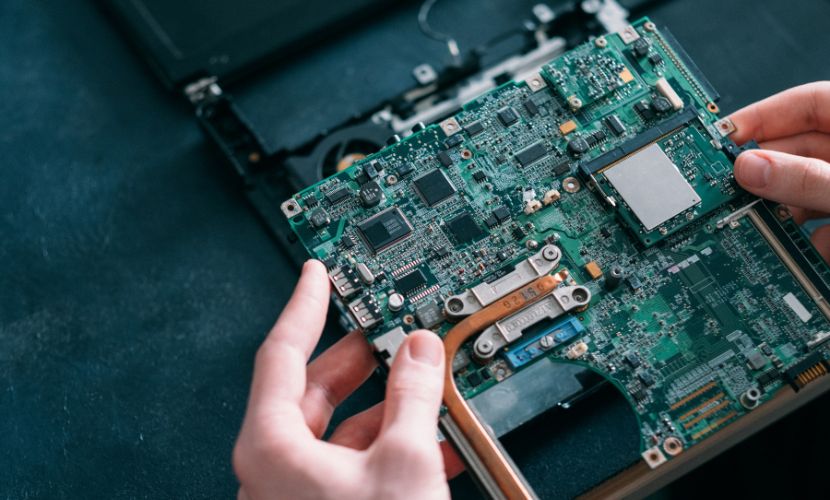Microelectronics Market Overview
The microelectronics market plays a crucial role in the global economy, serving as the backbone of numerous industries, including consumer electronics, automotive, telecommunications, and healthcare. Microelectronics involves the study and manufacture of very small electronic designs and components, such as semiconductors, microchips, and integrated circuits. The demand for more efficient, smaller, and powerful electronic devices drives innovation in this market. With advancements in technologies like AI, IoT, and 5G, microelectronics continues to evolve, fueling the digital transformation across various sectors. The market’s future growth is closely linked to technological advancements and increasing consumer demand for smart devices.
Microelectronics Market Size
In 2023, the global microelectronics market reached an impressive value of approximately USD 455.88 billion. This substantial market size underscores the critical importance of microelectronics in the modern technological landscape. As industries continue to digitize and demand for advanced electronic devices rises, the market is expected to witness significant growth. Projections indicate that by 2032, the market size could soar to USD 750.81 billion, driven by a compound annual growth rate (CAGR) of 5.70% from 2024 to 2032. This growth trajectory highlights the market’s resilience and its pivotal role in enabling technological advancements across multiple sectors.
Microelectronics Market Share
The microelectronics market is dominated by key players who have established significant market shares through innovation, strategic partnerships, and mergers and acquisitions. Companies like Honeywell International Inc., Schneider Electric SE, and Cisco Systems Inc. hold substantial shares due to their diverse product offerings and extensive global reach. The market is highly competitive, with numerous players contributing to its expansion. The dominance of established companies is challenged by emerging firms focusing on niche markets and advanced technologies. Regional market share is also influenced by the presence of manufacturing hubs, technological advancements, and government initiatives to support the electronics industry.
Microelectronics Market Trends
The microelectronics market is witnessing several key trends shaping its future. The rise of the Internet of Things (IoT) is driving demand for smaller, more efficient microelectronic components, enabling smarter devices and connected ecosystems. Additionally, the advent of 5G technology is pushing the boundaries of microelectronics, requiring faster, more powerful semiconductors and integrated circuits. Another significant trend is the growing emphasis on energy-efficient and sustainable electronic components, driven by increasing environmental concerns. The integration of artificial intelligence (AI) in microelectronics is also transforming the industry, enabling advanced functionalities in consumer electronics, automotive systems, and industrial automation.
Microelectronics Market Analysis
The microelectronics market is poised for robust growth, driven by increasing demand across various sectors. Consumer electronics remain a primary driver, with smartphones, tablets, and wearable devices continuing to evolve in functionality and efficiency. The automotive sector is another significant contributor, particularly with the rise of electric vehicles (EVs) and autonomous driving technologies, which require advanced microelectronics for sensor systems, power management, and connectivity. The healthcare industry is also increasingly reliant on microelectronics, particularly in medical devices and diagnostics, where precision and miniaturization are crucial. The telecommunications sector, fueled by the rollout of 5G networks, demands high-performance semiconductors and integrated circuits to support faster data transmission and enhanced connectivity. Moreover, industrial automation and the expansion of smart factories are driving the adoption of microelectronics in manufacturing processes. Despite challenges such as supply chain disruptions and the high cost of raw materials, the market is expected to maintain a steady growth trajectory.
Microelectronics Market Segmentation
The microelectronics market is segmented into various categories based on components, applications, and regions.
- By Components:
- Semiconductors: Includes integrated circuits, transistors, and diodes, which are essential in all electronic devices.
- Passive Components: Includes resistors, capacitors, and inductors, critical for controlling and managing electrical signals.
- Electromechanical Components: Includes switches, connectors, and relays used in various electronic circuits.
- Others: Includes sensors, microcontrollers, and optoelectronics.
- By Applications:
- Consumer Electronics: Smartphones, tablets, wearables, and home appliances.
- Automotive: Electric vehicles, autonomous driving systems, and infotainment systems.
- Healthcare: Medical devices, diagnostics, and patient monitoring systems.
- Telecommunications: 5G infrastructure, network equipment, and wireless communication.
- Industrial: Automation, robotics, and smart factories.
- By Regions:
- North America
- Europe
- Asia-Pacific
- Latin America
- Middle East & Africa
Microelectronics Market Growth
The microelectronics market is set for substantial growth over the next decade, driven by rapid technological advancements and increased adoption across various industries. The proliferation of smart devices, electric vehicles, and IoT applications significantly contributes to the demand for microelectronics. Additionally, the expansion of 5G networks globally is creating new opportunities for the development of high-performance semiconductors and integrated circuits. The market’s growth is also fueled by increasing investments in research and development, leading to innovations in miniaturization, energy efficiency, and functionality. The steady rise in consumer demand for advanced electronic devices further propels the market’s expansion.
Recent Developments and Challenges in the Microelectronics Market
The microelectronics market has seen several recent developments that are shaping its future trajectory. The ongoing miniaturization trend continues to push the boundaries of what is possible in microchip design, leading to more powerful yet smaller devices. The introduction of advanced materials, such as graphene and other two-dimensional materials, has opened new possibilities for faster and more efficient semiconductors. Additionally, the integration of artificial intelligence (AI) in chip design and manufacturing is enhancing performance and reducing development time.
However, the market faces significant challenges. Supply chain disruptions, exacerbated by global events, have led to shortages in critical components, affecting production timelines and increasing costs. Furthermore, the high cost of research and development, coupled with the complexity of designing and manufacturing cutting-edge microelectronics, poses a barrier for smaller companies trying to enter the market. Environmental concerns and the push for sustainability also require companies to innovate in materials and processes to reduce their ecological footprint.
Key Players in the Microelectronics Market
- Honeywell International Inc.: A leader in advanced electronics and control systems, Honeywell provides innovative solutions across aerospace, automotive, and industrial sectors.
- Jotrin Electronics Limited: Specializes in the distribution of electronic components, offering a wide range of products, including semiconductors, sensors, and integrated circuits.
- Ingersoll Rand Inc.: Known for its diversified industrial products, Ingersoll Rand has a strong presence in the microelectronics market through its precision-engineered components.
- Schneider Electric SE: A global leader in energy management and automation, Schneider Electric’s microelectronics offerings focus on smart grids, automation, and building management systems.
- Cisco Systems Inc.: A major player in networking and telecommunications, Cisco develops high-performance microelectronics for data centers, networking equipment, and security solutions.
- ACUITY BRANDS, INC.: Specializes in lighting solutions, leveraging microelectronics to develop energy-efficient lighting systems and smart building technologies.
- Johnson Controls: Offers a wide range of products and services in building automation, leveraging microelectronics to enhance energy efficiency, security, and comfort in buildings.
- Others: The market also includes other significant players like Texas Instruments, Intel Corporation, and Qualcomm, which are driving innovation and competition in the industry.
Thanks for allowing guest posting https://fantapa.com/



